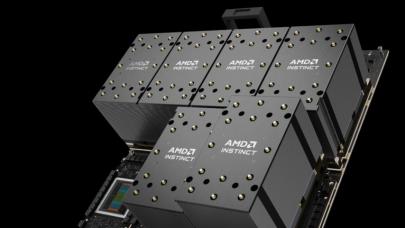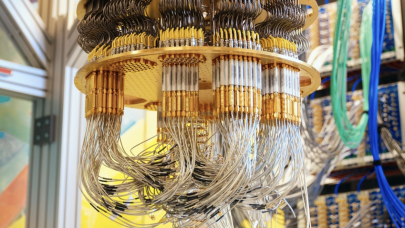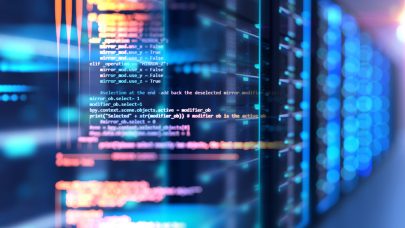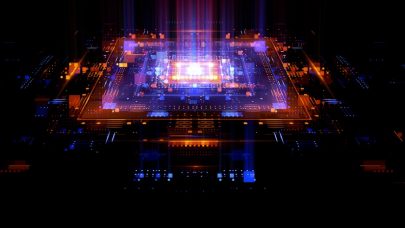Generations of Houstonian teachers, counselors, and parents have either worked in the aerospace industry or know people who do – the prospect of entering the field was normalized for boys in 1969 when the Apollo 11 mission carried astronauts Neil Armstrong, Michael Collins, and “Buzz” Aldrin to the moon and back. It was one of the first widely broadcast televised events; by then, about 90 percent of US households had TVs. Everyone heard Armstrong’s famous quote, “That’s one small step for man; one giant leap for mankind.” Since the 1980s, many notable women have become role models for girls who now entertain interstellar ambitions.
Main image: Alex Villeda (left) Intuitive Machines Composite Lead, and Guadalupe Hurtado, Intuitive Machines Jr. Electrical Engineering Technician. (Source: Nick Rios, Intuitive Machines.)
Houston is home to dozens of related businesses that have spun up near the National Aeronautics and Space Administration’s Lyndon B. Johnson Space Center – originally dubbed the Manned Spaceflight Center in 1961 and renamed in 1973 in honor of the former president from Texas. One such business is Intuitive Machines, the company that built the Odysseus Lunar Lander, which launched on February 15 and landed in the south polar lunar region on February 22, 2024.

San Jacinto Community College (SJC) and Intuitive Machines are based at the Houston Spaceport. The facility they share is called the “EDGE” Center, which fosters academic and industry collaborations that build the workforce needed by the public/private space ecosystem. “It’s not an acronym,” said Sarah (Sallie Kay) Janes, San Jacinto College (SJC) Associate Vice Chancellor for Continuing and Professional Development. “Activities in that facility take students to the EDGE of the future, with the leading EDGE of technology, using cutting EDGE education practices, located at the EDGE of the Houston Spaceport,” she added.
Intuitive Machines employs around 250 in the Houston area, including several who graduated from Texas A&M University’s Aerospace Engineering program. Naturally, Intuitive Machines Co-Founder, President, and Chief Executive Officer Steve Altemus has a vested interest in filling the talent pipeline, so it’s not surprising that he chairs the SJC Advisory Committee for Aerospace Programs. “Building a Nova-C class lunar lander took an incredible amount of touch labor, and we worked very closely with SJC to create a certification course for technicians,” said Altemus. “Then, Intuitive Machines gives new technicians an internship to test their skills in the workplace; we hire the most outstanding candidates on the spot,” he added.

Before Intuitive Machines was awarded the NASA contract to build its lunar program, they made drones and needed “composite” technicians. Altemus worked with SJC to create a Certified Aerospace Technician (Composites) certification program. Cyrus Shy, one of SJC’s first aerospace students, pursued the certification mid-way through his academic career. After graduating with an associate’s degree from Houston Community College in 2019, he completed SJC’s certification program in 2020, which led to a six-month internship and two-year role as a technician with Intuitive Machines. He will finish his baccalaureate degree at the University of Houston at Clear Lake in December and has already accepted a full-time position with Windhover Labs on the outskirts of Houston. “The Intuitive Machines drone-building internship made me realize that it’s what I want to focus on for the rest of my career. I’m grateful for the SJC certification and IM internship that helped me get my foot in the door at Windhover,” said Shy.

In the current high-tech landscape – driven by artificial intelligence workflows at the dawn of quantum computing – the need for new skills emerges quicker than traditional academic programs can respond. Certifications aren’t subject to the same accreditation hurdles and are, therefore, more agile. With the NASA award for delivering science and technology demonstrations to the Moon, Intuitive Machines worked with SJC to add new certifications and another internship program. Eighteen SJC students worked alongside Intuitive Machines engineers and research scientists to learn all facets of development – not only building the lander but analyzing wind dynamics, modeling/testing parts, and developing new software applications to operate it. They met NASA engineers who designed the navigation system and engaged with high-performance computing (HPC) through the Building Research Innovation at Community Colleges (BRICCs) program led by Texas A&M High-Performance Research Computing’s Dhruva Chakravorty (HPRC Director of User Services and Research).

Chakravorty emphasized that computing is the pathway toward building interinstitutional and multidisciplinary collaborations, like BRICCs and those that envisioned Odysseus. “Today, HPC accelerates discovery and innovation across the sciences,” said Chakravorty. “Computing is proving to be the new medium for growing nascent research programs. The Launch supercomputer, supported by the US National Science Foundation and hosted by HPRC, serves BRICCs and our other academic partners,” he added. Launch features an intuitive interface and policies that welcome everyone new to HPC.

SJC’s logo was printed on a side panel of Odysseus, and the names of the 18 interns were engraved on its landing gear. Among them were Mary Faith, Guadalupe, Nicole, and Delores, and surnames Baez, Hurtado, Murillo, Ortiz, and Villeda. Many of the 18 are first-generation college-bound. All were enlightened to the prospect of careers in advanced cyberinfrastructure, aerospace engineering, and software development and are better prepared for when they eventually land.
For more information about SJC and the EDGE Center, please visit their website.


































































